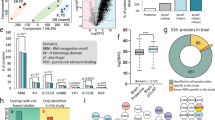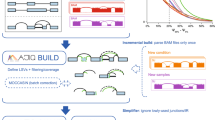Abstract
Protein–RNA interactions have critical roles in all aspects of gene expression. However, applying biochemical methods to understand such interactions in living tissues has been challenging. Here we develop a genome-wide means of mapping protein–RNA binding sites in vivo, by high-throughput sequencing of RNA isolated by crosslinking immunoprecipitation (HITS-CLIP). HITS-CLIP analysis of the neuron-specific splicing factor Nova revealed extremely reproducible RNA-binding maps in multiple mouse brains. These maps provide genome-wide in vivo biochemical footprints confirming the previous prediction that the position of Nova binding determines the outcome of alternative splicing; moreover, they are sufficiently powerful to predict Nova action de novo. HITS-CLIP revealed a large number of Nova–RNA interactions in 3′ untranslated regions, leading to the discovery that Nova regulates alternative polyadenylation in the brain. HITS-CLIP, therefore, provides a robust, unbiased means to identify functional protein–RNA interactions in vivo.
This is a preview of subscription content, access via your institution
Access options
Subscribe to this journal
Receive 51 print issues and online access
$199.00 per year
only $3.90 per issue
Buy this article
- Purchase on Springer Link
- Instant access to full article PDF
Prices may be subject to local taxes which are calculated during checkout




Similar content being viewed by others
References
Zaug, A. J. & Cech, T. R. The intervening sequence RNA of Tetrahymena is an enzyme. Science 231, 470–475 (1986)
de Duve, C. Co-chairman’s remarks: the RNA world: before and after. Gene 135, 29–31 (1993)
Maizels, N. & Weiner, A. M. The ‘last ribo-organism’ was no breakthrough. Nature 330, 616 (1987)
Gilbert, W. The RNA world. Nature 319, 618 (1986)
Sharp, P. A. On the origin of RNA splicing and introns. Cell 42, 397–400 (1985)
David, C. J. & Manley, J. L. The search for alternative splicing regulators: new approaches offer a path to a splicing code. Genes Dev. 22, 279–285 (2008)
Moore, M. J. & Silver, P. A. Global analysis of mRNA splicing. RNA 14, 197–203 (2008)
Mili, S. & Steitz, J. A. Evidence for reassociation of RNA-binding proteins after cell lysis: implications for the interpretation of immunoprecipitation analyses. RNA 10, 1692–1694 (2004)
Darnell, J. C., Mostovetsky, O. & Darnell, R. B. FMRP RNA targets: identification and validation. Genes Brain Behav. 4, 341–349 (2005)
Ule, J., Jensen, K., Mele, A. & Darnell, R. B. CLIP: a method for identifying protein–RNA interaction sites in living cells. Methods 37, 376–386 (2005)
Ule, J. et al. CLIP identifies Nova-regulated RNA networks in the brain. Science 302, 1212–1215 (2003)
Guil, S. & Caceres, J. F. The multifunctional RNA-binding protein hnRNP A1 is required for processing of miR-18a. Nature Struct. Mol. Biol. 14, 591–596 (2007)
van der Brug, M. P. et al. RNA binding activity of the recessive parkinsonism protein DJ-1 supports involvement in multiple cellular pathways. Proc. Natl Acad. Sci. USA 105, 10244–10249 (2008)
Buckanovich, R. J., Posner, J. B. & Darnell, R. B. Nova, the paraneoplastic Ri antigen, is homologous to an RNA-binding protein and is specifically expressed in the developing motor system. Neuron 11, 657–672 (1993)
Darnell, R. B. Developing global insight into RNA regulation. Cold Spring Harb. Symp. Quant. Biol. 71, 321–327 (2006)
Buckanovich, R. J., Yang, Y. Y. & Darnell, R. B. The onconeural antigen Nova-1 is a neuron-specific RNA-binding protein, the activity of which is inhibited by paraneoplastic antibodies. J. Neurosci. 16, 1114–1122 (1996)
Lewis, H. A. et al. Sequence-specific RNA binding by a Nova KH domain: implications for paraneoplastic disease and the fragile X syndrome. Cell 100, 323–332 (2000)
Ule, J. et al. An RNA map predicting Nova-dependent splicing regulation. Nature 444, 580–586 (2006)
Yang, Y. Y. L., Yin, G. L. & Darnell, R. B. The neuronal RNA binding protein Nova-2 is implicated as the autoantigen targeted in POMA patients with dementia. Proc. Natl Acad. Sci. USA 95, 13254–13259 (1998)
Ule, J. et al. Nova regulates brain-specific splicing to shape the synapse. Nature Genet. 37, 844–852 (2005)
Jensen, K. B. et al. Nova-1 regulates neuron-specific alternative splicing and is essential for neuronal viability. Neuron 25, 359–371 (2000)
Dredge, B. K. & Darnell, R. B. Nova regulates GABA(A) receptor gamma2 alternative splicing via a distal downstream UCAU-rich intronic splicing enhancer. Mol. Cell. Biol. 23, 4687–4700 (2003)
Dredge, B. K., Stefani, G., Engelhard, C. C. & Darnell, R. B. Nova autoregulation reveals dual functions in neuronal splicing. EMBO J. 24, 1608–1620 (2005)
Hu, J., Lutz, C. S., Wilusz, J. & Tian, B. Bioinformatic identification of candidate cis-regulatory elements involved in human mRNA polyadenylation. RNA 11, 1485–1493 (2005)
Zhao, J., Hyman, L. & Moore, C. Formation of mRNA 3′ ends in eukaryotes: mechanism, regulation, and interrelationships with other steps in mRNA synthesis. Microbiol. Mol. Biol. Rev. 63, 405–445 (1999)
Ben-Dov, C., Hartmann, B., Lundgren, J. & Valcarcel, J. Genome-wide analysis of alternative pre-mRNA splicing. J. Biol. Chem. 283, 1229–1233 (2008)
Blencowe, B. J. Alternative splicing: new insights from global analyses. Cell 126, 37–47 (2006)
Wang, G. S. & Cooper, T. A. Splicing in disease: disruption of the splicing code and the decoding machinery. Nature Rev. Genet. 8, 749–761 (2007)
Johnson, J. M. et al. Genome-wide survey of human alternative pre-mRNA splicing with exon junction microarrays. Science 302, 2141–2144 (2003)
Keene, J. D. RNA regulons: coordination of post-transcriptional events. Nature Rev. Genet. 8, 533–543 (2007)
Zhang, C. et al. Defining the regulatory network of the tissue-specific splicing factors Fox-1 and Fox-2. Genes Dev. 22, 2550–2563 (2008)
Markovtsov, V. et al. Cooperative assembly of an hnRNP complex induced by a tissue-specific homolog of polypyrimidine tract binding protein. Mol. Cell. Biol. 20, 7463–7479 (2000)
Polydorides, A. D., Okano, H. J., Yang, Y. Y., Stefani, G. & Darnell, R. B. A brain-enriched polypyrimidine tract-binding protein antagonizes the ability of Nova to regulate neuron-specific alternative splicing. Proc. Natl Acad. Sci. USA 97, 6350–6355 (2000)
Yuan, Y. et al. Muscleblind-like 1 interacts with RNA hairpins in splicing target and pathogenic RNAs. Nucleic Acids Res. 35, 5474–5486 (2007)
Grover, A. et al. 5′ splice site mutations in tau associated with the inherited dementia FTDP-17 affect a stem–loop structure that regulates alternative splicing of exon 10. J. Biol. Chem. 274, 15134–15143 (1999)
Early, P. et al. Two mRNAs can be produced from a single immunoglobulin mu gene by alternative RNA processing pathways. Cell 20, 313–319 (1980)
Rosenfeld, M. G. et al. Production of a novel neuropeptide encoded by the calcitonin gene via tissue-specific RNA processing. Nature 304, 129–135 (1983)
Iseli, C. et al. Long-range heterogeneity at the 3′ ends of human mRNAs. Genome Res. 12, 1068–1074 (2002)
Edwalds-Gilbert, G., Veraldi, K. L. & Milcarek, C. Alternative poly(A) site selection in complex transcription units: means to an end? Nucleic Acids Res. 25, 2547–2561 (1997)
Sandberg, R., Neilson, J. R., Sarma, A., Sharp, P. A. & Burge, C. B. Proliferating cells express mRNAs with shortened 3′ untranslated regions and fewer microRNA target sites. Science 320, 1643–1647 (2008)
Danckwardt, S., Hentze, M. W. & Kulozik, A. E. 3′ end mRNA processing: molecular mechanisms and implications for health and disease. EMBO J. 27, 482–498 (2008)
Burge, C. B. et al. Alternative isoform regulation in human tissue transcriptomes. Nature doi: 10.1038/nature07509 (this issue)
Zhang, H., Lee, J. Y. & Tian, B. Biased alternative polyadenylation in human tissues. Genome Biol. 6, R100 (2005)
Maniatis, T. & Reed, R. An extensive network of coupling among gene expression machines. Nature 416, 499–506 (2002)
Proudfoot, N. J., Furger, A. & Dye, M. J. Integrating mRNA processing with transcription. Cell 108, 501–512 (2002)
Gawande, B., Robida, M. D., Rahn, A. & Singh, R. Drosophila Sex-lethal protein mediates polyadenylation switching in the female germline. EMBO J. 25, 1263–1272 (2006)
Takagaki, Y., Seipelt, R. L., Peterson, M. L. & Manley, J. L. The polyadenylation factor CstF-64 regulates alternative processing of IgM heavy chain pre-mRNA during B cell differentiation. Cell 87, 941–952 (1996)
Veraldi, K. L. et al. hnRNP F influences binding of a 64-kilodalton subunit of cleavage stimulation factor to mRNA precursors in mouse B cells. Mol. Cell. Biol. 21, 1228–1238 (2001)
Clark, T. A. et al. Discovery of tissue-specific exons using comprehensive human exon microarrays. Genome Biol. 8, R64 (2007)
Acknowledgements
The authors are grateful to members of the Darnell and Ule laboratories and J. Richter for critical discussions and review of the manuscript, B. Friedman for suggesting the use of exon arrays, F. Allain for communicating unpublished results, and M. Suarez-Farinas for help with statistics. This work was supported by NIH R01 NS34389 (R.B.D.) and the Howard Hughes Medical Institute. R.B.D. is an HHMI Investigator.
Author Contributions D.D.L. and R.B.D. wrote the paper. D.D.L., A.M. and J.J.F. performed the biochemical and CLIP experiments. J.U. and M.K. developed ASPIRE2 and analysed exon junction array data. D.D.L., S.W.C., X.W. and R.B.D. did bioinformatic analysis. D.D.L, J.C.D. and R.B.D. analysed the data. T.A.C., A.C.S. and J.E.B. developed the exon junction microarray.
Author information
Authors and Affiliations
Corresponding author
Ethics declarations
Competing interests
T.A.C., A.C.S. and J.E.B. are employees of Affymetrix, Inc.
Supplementary information
Supplementary Information
This file contains Supplementary Methods, Supplementary Figures 1-9 with Legends, Supplementary References, and Supplementary Tables 1-2 with Supplementary References (PDF 2472 kb)
Rights and permissions
About this article
Cite this article
Licatalosi, D., Mele, A., Fak, J. et al. HITS-CLIP yields genome-wide insights into brain alternative RNA processing. Nature 456, 464–469 (2008). https://doi.org/10.1038/nature07488
Received:
Accepted:
Published:
Issue Date:
DOI: https://doi.org/10.1038/nature07488
This article is cited by
-
Unique transcriptomes of sensory and non-sensory neurons: insights from Splicing Regulatory States
Molecular Systems Biology (2024)
-
RNA structure: implications in viral infections and neurodegenerative diseases
Advanced Biotechnology (2024)
-
SRSF2 is required for mRNA splicing during spermatogenesis
BMC Biology (2023)
-
KDeep: a new memory-efficient data extraction method for accurately predicting DNA/RNA transcription factor binding sites
Journal of Translational Medicine (2023)
-
Complementary Alu sequences mediate enhancer–promoter selectivity
Nature (2023)
Comments
By submitting a comment you agree to abide by our Terms and Community Guidelines. If you find something abusive or that does not comply with our terms or guidelines please flag it as inappropriate.



